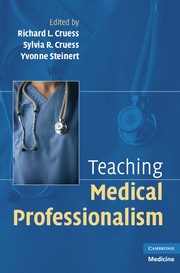Book contents
- Frontmatter
- Contents
- List of Contributors
- Foreword by William M. Sullivan
- Introduction
- PART ONE WHAT IS TO BE TAUGHT
- PART TWO THEORY
- PART THREE PRINCIPLES
- PART FOUR PRACTICE: CASE STUDIES IN TEACHING PROFESSIONALISM ACROSS THE CONTINUUM
- APPENDIX A Definitions of Professionalism
- APPENDIX B Core Attributes of Professionalism
- APPENDIX C The Teaching of Professionalism: Vignettes for Discussion
- APPENDIX D A Matrix for “Matching” Teaching Methods to Attributes
- APPENDIX E Sample Grid for Use with Discussion of Vignettes
- APPENDIX F Sample Questions to Guide Discussion about the Social Contract: Small-Group Leaders' Guide with Suggested Responses
- APPENDIX G Professionalism Program for Residents: Suggested Outline for Small Group Facilitators
- APPENDIX H Sample Evaluation Form for Residents' Half-Day Program on Professionalism
- Index
APPENDIX C - The Teaching of Professionalism: Vignettes for Discussion
Published online by Cambridge University Press: 01 September 2009
- Frontmatter
- Contents
- List of Contributors
- Foreword by William M. Sullivan
- Introduction
- PART ONE WHAT IS TO BE TAUGHT
- PART TWO THEORY
- PART THREE PRINCIPLES
- PART FOUR PRACTICE: CASE STUDIES IN TEACHING PROFESSIONALISM ACROSS THE CONTINUUM
- APPENDIX A Definitions of Professionalism
- APPENDIX B Core Attributes of Professionalism
- APPENDIX C The Teaching of Professionalism: Vignettes for Discussion
- APPENDIX D A Matrix for “Matching” Teaching Methods to Attributes
- APPENDIX E Sample Grid for Use with Discussion of Vignettes
- APPENDIX F Sample Questions to Guide Discussion about the Social Contract: Small-Group Leaders' Guide with Suggested Responses
- APPENDIX G Professionalism Program for Residents: Suggested Outline for Small Group Facilitators
- APPENDIX H Sample Evaluation Form for Residents' Half-Day Program on Professionalism
- Index
Summary
FOR UNDERGRADUATE PRE-CLINICAL MEDICAL STUDENTS
First identify the elements, characteristics, or attributes of professionalism raised by each of the following cases. You may then discuss solutions to the problem.
Case #1
You notice a colleague reading the chart of a patient who is a personal friend of the colleague. He has not been involved in the patient's care. You know that the chart has some sensitive personal information in it.
Case #2
The medical school assigns families to first-year students for early clinical experience. You are on an elevator and hear a student discussing his assigned family, including the names of the family, in derogatory terms.
Case #3
A drug company representative gives you a stethoscope with the name of an expensive cardiac medicine prominently displayed on it.
Case #4
A student observes an exemplary student during the end of semester final using a textbook during a major closed book examination.
Case #5
A patient and family that you have been assigned to follow gives you information that may influence care and asks that you do not tell anyone, including the patient's doctor.
FOR UNDERGRADUATE CLINICAL MEDICAL STUDENTS
First identify the elements, characteristics, or attributes of professionalism raised by each of the following cases. You may then discuss solutions to the problem.
Case #1
A final-year medical student believes the attending surgeon is inebriated while performing an operation.
Case #2
A senior resident asks a medical student to put in an arterial line. The student has never seen or performed this procedure before. The resident explains the technique, then tells the student to proceed and leaves.
- Type
- Chapter
- Information
- Teaching Medical Professionalism , pp. 287 - 290Publisher: Cambridge University PressPrint publication year: 2008



